On the night of December 8, 2013, a huge crowd gathered on a tree-lined boulevard in downtown Kyiv, the capital of Ukraine. The crowd was there to watch as a statue in the boulevard was pulled down by a crane. The toppled statue was of Vladimir Lenin — the communist leader who started the revolution that created the Union of Soviet Socialist Republics (USSR). Ukraine was once a part of the Soviet Union.
A documentary film called “All Things Ablaze” captured this moment. The camera lingers on one man in a shiny tracksuit who spits on his hand, crosses himself three times, then starts whacking away with a sledgehammer with all his might. For the protestors, this Lenin statue represents old Ukraine — one that is associated with the Soviet Union and with Russia.
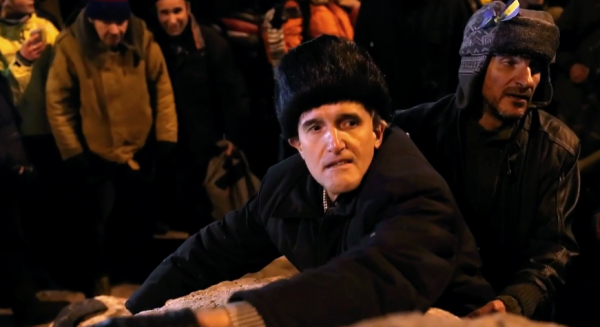
The same protests that brought down that Lenin statue eventually brought about a new government in Ukraine, which sought to eliminate all physical reminders of communism and Russia. But it hasn’t been easy, logistically or politically, because removing these things erases history that is still important to some Ukrainians. Furthermore, communist symbols are very pervasive in the built environment — they can be found on buildings, bridges and other infrastructure.
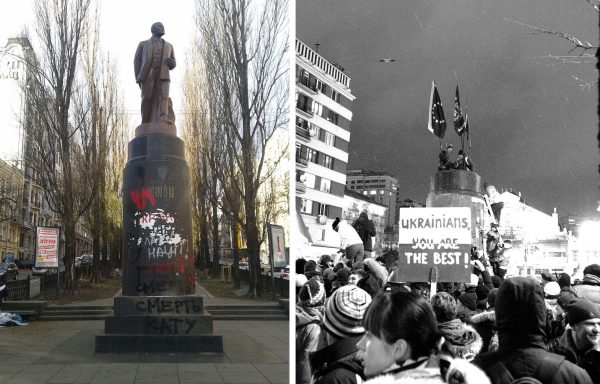
Ukraine is a country about the size of Texas that is bordered by Russia to the east, and the rest of Europe to the west — in fact, the word “Ukraine” means “borderlands,” which is why some people still (erroneously and to the frustration of Ukrainians) call it “the Ukraine.”

In the 1920s much of the territory of what is now Ukraine became a part of the Soviet Union. Then, in the 1930s, millions of Ukrainians died in a famine that Stalin engineered by forcibly taking food from peasants. Ukrainians call this famine the Holodomor and many scholars believe Stalin orchestrated it specifically to cripple the movement for Ukrainian independence.
A decade later, during World War II, hundreds of thousands of Ukrainians, especially people in the east, fought and died with the Soviet Red Army. But a smaller number in the west wanted an independent Ukraine and allied themselves with Germany, fighting alongside the Nazis.
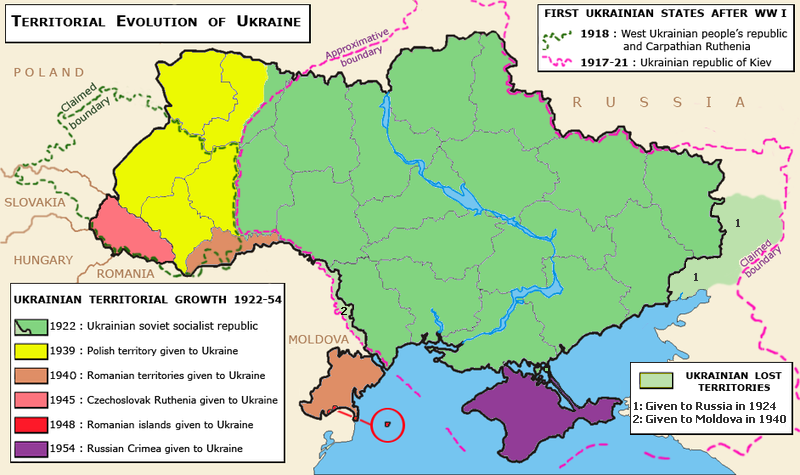
When it was all over, even more Ukrainian territory was part of the USSR. Soviet authorities wanted the people of Ukraine to unite around the narrative that they had defeated the Nazis and that communism would help the country rebuild. As part of a campaign to unite Ukraine under the banner of communism, the Soviets put statues of USSR’s founding father, Vladimir Lenin, everywhere — more than 5,500 of them.
In 1991, the Soviet Union collapsed and Ukraine became an independent country, as did Russia. Russia has since become less communist and more capitalist, but the leadership of the country, especially current president Vladimir Putin never stopped being proud of the Soviet legacy. Ukraine, meanwhile, has struggled with its identity as a nation since gaining its independence.

It has been hard for Ukraine to completely cut ties with Russia. For one, Ukrainians rely on their neighbors to the east for coal and gas, but the people of Ukraine also have strong cultural connections to Russia. For years, the country seemed to vacillate — some presidents of Ukraine leaned west toward Europe, some oriented east toward Russia.
As for the statues of Lenin and other symbols of communism in the built environment: in western Ukraine, where people felt less loyalty to the Soviet era, these symbols came down quickly after independence. However, in eastern Ukraine, the statues mostly stayed put. The will to remove them just wasn’t there.
Then in 2013, when the pro-Russia president Viktor Yanukovych tried to back out of a deal to bring Ukraine closer to joining the European Union, protests broke out, and the people began pulling down Lenin statues on their own. The tide had turned. Ukrainians were in the streets saying they didn’t want to be tied to Russia anymore. So many statues were pulled down that there was even a name for the phenomenon: “Leninopad” (which translates as “Leninfall” or “the falling of the Lenins”).
In February of 2014, following days of bloody protests, Viktor Yanukovych was forced out of the presidency and fled to Russia. The protesters in Ukraine established a new government.
Russian President Vladimir Putin, meanwhile, was displeased to see Ukraine turning away from Russia and toward the European Union and NATO. And in March of 2014, he expressed his feelings by taking control of a part of Ukraine called Crimea. Soon after, battles broke out in eastern Ukraine between Russian-backed separatists and the Ukrainian military which continue today. At least 10,000 people have died.
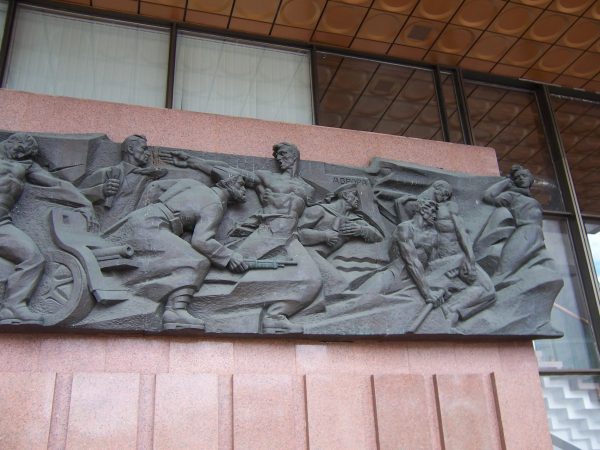
Partly because of these encroachments by Russia, Ukraine’s new government, led by Petro Poroshenko, decided to make the removal of Lenin statues into state policy. Ukraine’s parliament passed a package of bills called “decommunization laws.” Local authorities had a year to get rid of their Lenin statues. If their town or streets had communist names, those had to be changed, too.
Some places in Ukraine have taken a creative approach in complying with the decommunization laws. A factory in Odessa, for example, hired a sculptor to refashion a figure of Lenin as Darth Vader.

Overseeing the removal of all of these monuments and symbols, and the changing of place names, is a government organization: The Ukrainian Institute of National Remembrance.
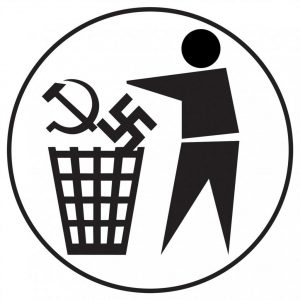
According to the Institute of National Remembrance, the process of decommunization isn’t just about removal — it’s also meant to help Ukrainians learn their own history. Which is why, in many cases, they have suggested that towns revert to the names they had before the Soviets changed them. But whether they choose to revert to old names or pick new ones, Ukrainians do not have the option of keeping the Soviet names.

A major criticism of the decommunization laws is that they constitute an authoritarian approach to separating Ukraine from its authoritarian past. Not only do these laws dictate changes in town names, they make it illegal to join the Communist Party, display Soviet propaganda, or deny the “criminal nature” of the Soviet regime (which is not well defined in the law). It’s unclear if even wearing a communist t-shirt could be considered a punishable offense.
Since the process of removing communist symbols began in 2014, more than 50,000 places and objects have been renamed, including cities, towns, villages, streets, squares and parks. And more than 2,000 monuments and memorials have been taken down or modified.
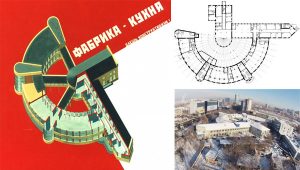
In general, these changes have been the hardest on the nation’s older population — the people who lived under Soviet rule who didn’t necessarily understand how bad it was for other Ukrainians. Because the Soviet Union didn’t have a free press, or freedom in academia, the extent of the repression was hidden from the general public. Some Ukrainians are just now finding out that millions of people died because of Stalin, and that millions more were put into gulags.

Meanwhile, Russia still exerts a lot of political influence in Ukraine and there are pro-Russia forces within the country that could cause trouble for a long time. For many Ukrainians, the removal of communist symbols from the built environment is an important step as Ukraine continues to develop as an independent nation.




Comments (25)
Share
Hi,
I was in Fremont, Seattle, Washington a few years ago and was amazed to see a Statue of Lenin!! It was the most surprising thing. I wonder how many Lenin statues stand around the world totally out of context. With so many Lenin Statues existing there must be more that were brought out of Ukraine and ended up somewhere else. I’d listen to that Podcast (though of course, I listen to all your podcasts)!
Thanks for the entertainment.
Olivia (Dublin, Ireland)
Great episode Team. It reminded me that there is a Lenin statue in Seattle somewhere. Bit closer to beautiful downtown Oakland California than the war torn streets of Kiev! Saw it when we passed through on our USA road trip a couple of years ago. It was brought over from Slovakia I think. His left hand is painted red to symbolise the blood spilled by the communists… There’s a photo on our semi REM themed travel blog if you fancy a look…. :)
Keep up the good work!
Dave and Kirralee – biggest 99pi fans in Australia!!
http://www.mexicotonewyork.com/wp-content/uploads/2014/08/Portland_Seattle_010a.jpg
I don’t think you’d have a problem with how Germany legally treats their Nazi past right? then don’t be so surprised the Ukrainians do the same with a system that killed and brutalised even more people.
And I’d even say that many people in the west are now waking up to what communism stands for and what it did. We must treat communism the way we treat national socialism.
Nah, Ukraine has nazi militias until today, their problem was always nazism and catholicism
It is true story. I am from Ukraine. I took part in great protests in 2001, 2004 and in 2013. I was making “molotov cocktails” next corner when first Lenin was demolished. I saw that man who want to save Lenins monument, my ultra-left comrades even ttied to reconcile him. I did not participate in revenge against statue. I thought it is not efficient using of social rage. And now I sure that war with monuments it is fake and not right way for our country, in place of economical changes, developing of democracy and free market.
A serious and informative piece of work. What’s missing, however, is a central (not side) aspect of the story: thanks largely to the extremely activist and politicized leadership of the Ukrainian Institute of Memory, the decommunization policy is also used to shield Ukrainian nationalists, especially during World War Two, from public debate and criticism of their real historical record, which included ethnic cleansing massacres and participation, to one substantial extent or the other, in the Holocaust. (These facts have nothing to do with “Russian information warfare.”) This “linkage” between decommunization (aimed at loosening the hold of Soviet myths) and nationalist revisionism (aimed at strengthening the hold of nationalist myths, which are untruthful and also divisive in Ukraine itself) is not at all necessary or “natural.” Instead it was deliberately constructed and enshrined in law precisely by the head of the Institute of National memory. Thus what is presented to the West as ‘simply’ decommunization also serves the ethno-nationalization of memory – and it’s meant to do so. Decommunization may have genuine rationales; it is also a cover. It is quite a tragedy to see how the attack on one set of authoritarian myths (of the far left) is used to help install another one (of the far right).
This is an extremely important point, and I’m so glad that Professor Amar brings it up here. As a reporter, I really wrestled with explaining the complex historical factors behind Ukraine’s decommunization — it’s a struggle to do justice to all that in an audio format for a general audience. Prof. Amar has a very valid criticism of the piece and really any story that tries to take on a history such as Ukraine’s in the 20th century, with its multiple layers of tragedies, repression, ideology and warfare. I’d urge everyone to check out this piece about the uglier side of Ukrainian nationalism here: http://www.tabletmag.com/jewish-news-and-politics/166945/no-time-to-waste-in-ukraine Also listen to Prof. Amar’s recent interview on WNYC’s On the Media about his concerns: http://www.wnyc.org/story/radical-historian-rewriting-ukraines-past
Valid point. As mentioned in the piece, Ukraine ‘continues to develop as an independent nation’. These debates around decommunisation, strong palarisation between east and west, desertions in Ukrainian army during the ongoing conflict and especially the abovementioned idea to instill Stepan Bandera, a psychopath mass murderer, as a national hero (!) speak for themselves. There’s an extremely long way to go. In Poland for example laws also dictate changes in town names (and street names, which are currently undergoing a thorough decommunisation), they make it illegal to even start a Communist Party, display Soviet propaganda, the “criminal nature” of the Soviet regime is as clear as a blue sky and yes – wearing a communist T-shirt is forbidden by law and even if it wasn’t, doing so can get you in serious trouble. But Poland was a well constituted nation well before the communist regime was installed in 1945. Ukraine at the time was in the beginning of the definition of the nation, stopped by the WW2 and the post-war order. I hope they’ll finally make it.
You are completely missing context with your WWII comment. The nationalists had zero interest in ethnic cleansing. All they wanted was to have the freedom to speak their language and practice their religion. Stalin’s agenda was always to erase Ukrainians as a people and erase their culture (which is why he killed millions of them in the most horrific ways and sent more millions to labor camps). Hitler, who also believed Slavic people to be inferior, didn’t however, have a priority of ridding the world of everything Ukrainian. Thus, the Ukrainians hoped that if they sided with Hitler, he would help them be free of Stalin. This lasted very briefly, as Ukrainians quickly learned that Hitler has no intention of helping them what so ever. My home town in Ukraine was largely Jewish and many of my Ukrainian family members who were nationalists never had any issues with the Jewish population. Many of them participated in the anti-Stalin resistance AND helped to save many Jewish friends.
Every single family in my city in Ukraine has dozens of horrific recollections of how Russians killed, tortured, starved, sent to labor camps, burnt, and raped many members of their families for several generations . If you lived in that reality (or you can read any Ukrainian literature from the last 250 years), you would understand why there was this very brief military alliance with the Germans. Ethnic cleansing was never part of the Ukrainians’ agenda, only the freedom to be Ukrainian. The “Ukrainian nationalists are Nazis” argument is a cliche, brainwashing tactic used by the Russians. Based on the events that continue today, it is clear that Russia is still trying to get rid of us.
This was a fascinating episode and I appreciated the attempt to explain why some people in Ukraine may still feel nostalgia and appreciation for the symbols of a regime that was, by any standards, murderous and oppressive. I would be curious to see if a future episode of podcast could cover the issue of Confederate memorials and monuments in the southern United States with a similar degree of evenhandedness.
This was a great episode about a very serious and current issue. However, i’m struggling to find the design aspect of it all. I know that one of the key beliefs of the podcast is that design is found everyhere (an idea i completely agree with), but talking about Ukraine, using the angle of the statues, seems like a stretch to me.
I had the same thoughts about the Stone Wall Riots episode.
What do you guys think? Does it even matter when the quality of the podcast is just as great as the ones concerning infrastructure, architecture, fashion and other more obvious design stories?
Great episode! There’s a site that collects a huge database on all the Lenin statues around the world (9,359 at the moment). Naturally, it tracked Leninopad:
http://leninstatues.ru/leninopad
And the Seattle statue is obviously not the only one in the US:
http://leninstatues.ru/place/ssha
Lenin is as despicable as Hitler. There is no justification for his images still being around the world, unless you’re a real fascist or you don’t know a thing of history.
There is about 2 minutes missing from the episode availble from the podcasts app. I found the missing parts available here, but thought others might have a similar problem. The episode from the podcasts app jumps about 24 seconds into the episode and cuts the intro story out completely.
Can you tell us what kind of device (make/model) and which app you are using?
Device: iPhone 6 Model A1586
App: Podcasts version 2.5.2 (1140.8)
I grew up in Fremont, Seattle, and as a kid I walked past a giant Lenin statue everyday. I never completely understood why this Lenin statue was in the middle of Seattle, a rather progressive city. I always liked the statue, because it was a landmark that always made it really easy to explain where I lived. I’ve long since moved away, and over the years it seems more and more out of place. I really appreciated this episode, and it opened my eyes to some of my sheer ignorance. I’m curious what the general response is to the Seattle statue, do people want to take it down? Have people tried? How did it end up there? Who fought against having it there?
A Ukrainian living in Ukraine here. Gals you get a solid A for your effort. Yet a C for the quality of your material. Sorry, I see you did extensive research and tried very hard, but there’s a bunch of things you got wrong. I also know that language barrier is a problem, Ukrainian materials are harder to discover if you don’t speak the language, although Google Translate works wonders these days. Some criticism below:
THE ARTICLE
* Removing statues is not erasing the history. Removing statues is removing statues.
* The word “Ukraine” does not mean “borderlands”, in fact we don’t know what it means and what are its origins.
* Holodomor was not orchestrated to crush the independence movement, it’s been crushed long before that. The Holodomor (the largest of several orchestrated famines) targeted the farmers who didn’t want to join the Kolkhozs (communist collective husbandry). Most of Ukrainians were farmers back then.
* “A decade later, during World War II, hundreds of thousands of Ukrainians, especially people in the east, fought and died with the Soviet Red Army.”
– nope, millions (not hundreds of thousands) of Ukrainians fought and died in the WWII, conservative estimate is at least 1.3M dead, other estimates state about 10M of military, partisans and civilians deceased. Ukraine was the largest war theater in the Eastern Europe. Millions of Ukrainian soldiers after defeating Nazis in the USSR went on to liberate Europe and a significant number (can’t give you the number off the top of the head) went on to liberate China. Pretty much everybody, not just the people in the east of Ukraine fought the Nazis.
* The map you use in the article is manipulative. Possibly put together by these “Russian trolls”. I assure you nobody “gave” territories to anyone ever. Especially in the first half of the XX century. Also, all of the territories marked on the map are populated by ethnic Ukrainians, which is why they are called Ukraine.
* All of the Ukrainian presidents leaned toward Europe, except Yanukovych. Strong connections with Russia, however, really existed, their remnants still exist.
* You keep saying “Western Ukraine” and “Eastern Ukraine”, that’s not how Ukraine is organized. It consists of (clockwise, north oriented) Northern, Eastern, Southern, Western, and Central Ukraine. Also, note this is not the administrative division, but rather a convenient way of referring to the parts of the country.
* “…protests broke out, and the people began pulling down Lenin statues on their own.”
– nope, the statues were being removed months later.
* “In February of 2014, following days of bloody protests, Viktor Yanukovych was forced out of the presidency and fled to Russia. The protesters in Ukraine established a new government.”
– this is false and ridiculous. Yanukovych was never “forced” out of presidency, he just fled. The protesters never established any form of government and most went home in early March 2014. Presidential elections were scheduled (after Yanukovych went missing) for June 2014 by the Parliament elected in 2012. Parliamentary elections were scheduled for 2015 by the same Parliament as well.
* “It’s unclear if even wearing a communist t-shirt could be considered a punishable offense.”
– it’s pretty clear that wearing a communist t-shirt is not a punishable offence if you read the actual law (which, I guess, you didn’t).
* “Because the Soviet Union didn’t have a free press, or freedom in academia, the extent of the repression was hidden from the general public.”
– although the USSR really didn’t have free press, the general public was absolutely aware of the repressions, since it was the general public being repressed.
* “Some Ukrainians are just now finding out that millions of people died because of Stalin, and that millions more were put into gulags.”
– although there might be, like, five people in Ukraine who’ve been living under a rock for years, which constitutes as “some”. The overwhelming majority of Ukrainians are well aware of Stalin’s atrocities and the GULAGs
* “Meanwhile, Russia still exerts a lot of political influence in Ukraine and there are pro-Russia forces within the country that could cause trouble for a long time.”
– Russia has about zero political influence here as of now. But Russian government has agents of influence embedded in the Ukrainian political system as well as a horde of spies. That is a real problem we are facing today.
VIDEO:
* nope, Ukraine is not divided as shown on the map in the video, in fact the division demonstrated comes from vote results in 2004 presidential elections (Yuschenko vs Yanukovych), and means just that, the dynamics have been changing quite a bit since then. The map, however, was used a lot by Russian propaganda, so, I guess, that’s why it’s pretty common on the Internet.
* nope, Crimea doesn’t sit on oil and gas, in fact it doesn’t sit on anything valuable. There’s some oil and gas in the Black Sea shelf, but it’s closer to Romania and Odessa county than to Crimea.
* Ukrainians are bilingual, stats showing 46% of russian speakers are wrong. 99% of Ukrainians speak Russian including me. That’s due to how Soviet and post-Soviet education system worked. There are, however, maps showing prevalance of Ukrainian/Russian language by region and those maps are nothing like what is shown in your video.
* nope, we don’t know how many people of Crimea voted for joining Russia, since we don’t know how many voters participated in the “referendum”. The registry of voters for the entire country is held some place in Kyiv (unlike the US, you don’t need to register for voting, but instead you get an invitation for each election/referendum by mail if you are in the registry. Every citizen of Ukraine becomes a voter automatically upon reaching 18) Also, the options in the ballots were loaded. Also-also, the ballots weren’t protected by watermarks and stuff and could be copied easily. Basically the whole event was bogus as hell.
COMMENTS:
* To Tarik Cyril Amar, dear sir, please, do you research. The public debate on UPA role is raging as it’s always been. Decommunisation is not aimed at loosening Soviet myths, those died long ago during Perestroika. Nationalist revisionism is literally what is NOT happening. The Institute of National Remembrance is just another useless government department leeching off the taxpayer money, you are grossly overestimating its role.
“It is quite a tragedy to see how the attack on one set of authoritarian myths (of the far left) is used to help install another one (of the far right).”
– it’s a tragedy to see a professor making judgements without any prior research or understanding of the subject.
So, that’s that. Feel free to ask any questions, clarifications, sources, etc. I didn’t include sources in this comment, because it already got a lot longer and took more time than I initially expected and it’s 1am already here, but if you need some, dear reader, some I’ll get them for you.
Thank you for the extensive and thoughtful comment, Anton! Are there sources in English that you recommend on Soviet and post-Soviet Ukrainian history?
Thank you, Anton. I was just typing out many of the exact same comments here on the map, the comments, and other details of the podcast.
I was also furious That the one source they had “we share the same language (referring to Russia)” HELLO!!!! How about the UKRAINIAN language that many millions of us use and many millions lives were lost to preserve?!?!? Unbelievable!
Please see my response to Tarik Amar — seeing people spread falsehood about our people is incredibly frustrated.
99% Invisible — this podcast was promising, but ultimately disappointing and has reduced my trust in your reporting abilities.
P.S. Anton, I think when you say 99% Ukrainians speak Russian, you mean that 99% of Ukrainians CAN speak Russian. In the west, were I grew up, we all spoke Ukrainian. The fact that much of central, easter, and southern part of Ukraine is speaking Russian right now is the success of Stalin’s and Lenin’s deUkrainization.
I wish there was a way to reverse that, but it is a personal opinion.
From May 3-17, 2017, Lenin’s former pedestal will be transformed into a hanging herb garden: https://izolyatsia.org/en/project/social-contract-2017
Some photos of the installation going up: https://www.facebook.com/hmaro4os/posts/1554288351270969
And another re-imagining has happened at the other end of Kiev’s main boulevard: https://www.buzzfeed.com/susiearmitage/a-soviet-monument-got-a-rainbow-makeover-and-people-have?bftwnews=undefined&utm_term=.ujMePGmMd#.pcamN9wrz
Pretty sad to see you use “Kiev” instead of “Kyiv”, especially considering you mention the difference between “The Ukraine” and “Ukraine” in the podcast. Could you please correct this in the article?
Done – thanks for letting us know!